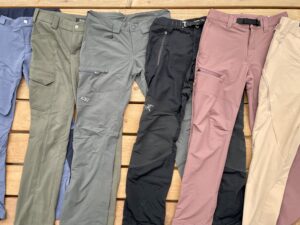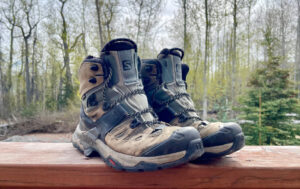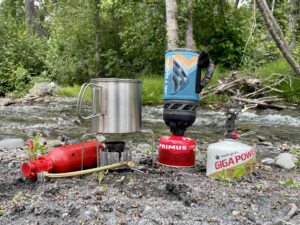If you’re just getting started in mountaineering, there’s a lot to learn and buy. The best mountaineering boots, crampons, and other alpine climbing tools can last a lifetime.
From ice climbing to glacier travel to hiking in the snow, mountaineering boots are necessary for many outdoor adventures. A step up from your average hiking boot, mountaineering boots are sturdier, waterproof, and often very stiff. But unlike other boots, they’re designed to protect your feet from snow and ice and provide a stable surface to attach crampons.
Whether you’re a seasoned veteran or a young gun, this list of the best mountaineering boots will help you.
The best mountaineering boots
Best summer mountaineering boots: Scarpa Charmoz HD Mountaineering Boots

- HDry technology
- Synthetic leather
- Semi-automatic crampon compatible
- Full rubber rand
Pros:
- Comfortable
- Water-resistant
- Quick break-in
- Lightweight
Cons:
- Not super warm — don’t wear them in extreme cold
I’ve worn an older version of these boots for years, in all conditions. The Charmoz is a great lightweight, comfortable option for summer mountaineering boots. The 3/4 shank makes hiking comfortable, while the HDry technology keeps your feet dry while allowing them to breathe. The synthetic leather and fabric upper breathes well and dries quickly.
For alpine-climbing performance, the full rubber rand provides security on rock. These boots also have a heel welt which makes them compatible with semi-automatic crampons for climbing snowy, icy, and technical terrain. The multi-density PU + EVA midsole balances weight and performance. While not the ideal boot for steep ice climbing, I have worn them for top rope ice climbing before and they do the trick as long as you’re not planning to lead anything.
Overall, this is a great mountaineering boot for three-season mountaineering and hiking.
See Scarpa Charmoz HD Mountaineering Boots on Amazon
Best mountaineering boot for ice climbs: La Sportiva Men’s Nepal Cube GTX Boot

- Carbon tech honeycomb insole
- Insulated Comfort GORE-TEX lining
- Adjustable, removable tongue
- 3D flex ankle
Pros:
- Great climbing performance
- Warm
- Tall enough to keep snow out
Cons:
- Stiff full shank isn’t as comfortable to hike in
One of the most popular mountaineering boots for ice and mixed climbing, the La Sportiva Nepal Cube GTX mountain boots are a great option for four-season technical climbing and mountaineering. The Carbon Tech honeycomb insole is highly insulating to keep cold feet at bay. Plus, it’s stiff, lightweight, and low profile, so you feel secure in each foot placement without heavy boots dragging you down. The insulated Comfort GORE-TEX lining adds extra warmth while wicking any interior moisture. Toe and heel welts make these compatible with any crampon type.
I’ve worn a version of the La Sportiva Nepal for ice climbing and find their technical climbing performance to exceed other boots I’ve tried. They have a rigid sole that, coupled with a pair of step-in crampons, feels secure with every kick into the ice climb. While not as warm as double boots, these keep my feet warm in most conditions.
See La Sportiva Men’s Nepal Cube GTX Boot on La Sportiva
Best leather full-shank mountaineering boot: La Sportiva Men’s Makalu Mountaineering Boot

- Idro-Perwanger Roughout leather
- Full-shank boots
- EZ Rollerball and D-ring lacing
- Protective Vibram rand
- Aggressively lugged outsole
Pros:
- Super durable
- Traditional leather style boot
- Can use for trade work as well as mountaineering
Cons:
- Take time to break in
- Narrow fit like many of La Sportiva’s boots
La Sportiva’s Makalu mountaineering boot is a classic leather boot with all the upgraded technology that modern boots need.
The MPEvo rubber aggressively lugged outsole grips loose or rocky terrain. The upper is made out of 3mm Idro-Perwanger Roughout leather, a premium silicone-impregnated leather made from the corium, the strongest part of the leather. The leather is tanned to be incredibly water-repellent while remaining breathable. A Vibram rubber rand adds protection for the toe box and the EZ rollerball lacing system makes it easy to lace these up. These full-shank boots have automatic crampon compatibility but can also be used with a hybrid or strap-on crampon.
See La Sportiva Men’s Makalu Mountaineering Boot on Amazon
See La Sportiva Men’s Makalu Mountaineering Boot on Backcountry
See La Sportiva Men’s Makalu Mountaineering Boot on Moosejaw
Best leather 3/4 shank mountaineering boot: La Sportiva Karakorum Mountaineering Shoe

- Idro-Perwanger Roughout Leather
- New-matic crampon compatibility
- SBR Aircushion provides comfort and insulation in any weather
- Aggressive Vibram rubber sole
Pros:
- Great boot for any conditions
- Waterproof and breathable
Cons:
- Take a while to break in
- Insoles not very comfortable
- Narrow fit
If you’re looking for a heavy-duty hiking boot that can stand up to some mountaineering, the La Sportiva Karakorum is a great option. These boots are similar to the Makalu but have a 3/4 shank instead of a full shank, making them more comfortable for hiking. However, they are not compatible with fully automatic crampons.
They feature 2.8mm durable Idro-Perwagner silicone-impregnated leather uppers that are weather resistant. The multi-directional 3D flex hinge adds flexibility and promotes a faster break-in period while still providing stability.
The SBR Aircushion sole helps to cushion your feet and keep them warm in chilly climates and cool in hot conditions. Plus, the aggressively lugged Vibram rubber sole includes heel welts, giving them semi-automatic crampon compatibility. These boots are a solid, durable option for backpacking and mountaineering. They have a classic style without the weight of old-school leather boots.
See La Sportiva Karakorum Mountaineering Shoe on Amazon
Best lightweight mountaineering boots: Salewa Men’s Crow GTX Mountaineering Boots

- Abrasion-resistant fabric upper
- Breathable Gore-Tex liner
- Vibram Mulaz Sole
- Semi Automatic crampon compatible
- Full rubber rand
Pros:
- Waterproof
- Comfortable
- Great heavy-duty hiking and summer mountaineering boots
Cons:
- Not great for winter mountaineering or technical ice climbing
- Narrow fit in the toe
These boots feature an abrasion-resistant fabric upper and a GORE-TEX lining for breathable waterproofing. The Vibram New Mulaz Sole provides plenty of grip on technical rock as well as mixed mountain terrain and snow. Plus, they’re compatible with semi-automatic crampons for glacier travel or light ice climbing.
SALEWA offers a 100% blister-free guarantee and they use a 3F System for heel and ankle support to get there, while the Flex Collar allows for comfort during descents. The climbing lacing systems keep your foot in place on steep terrain and provide ankle support. Plus, the Gore-Tex performance comfort lining wicks moisture while providing a waterproof barrier when the weather turns.
See Salewa Men’s Crow GTX Mountaineering Boots on Amazon
See Salewa Men’s Crow GTX Mountaineering Boots on Moosejaw
Best waterproof mountaineering boot: Salewa Men’s Rapace GTX Mountaineering Boot

- Breathable Gore-Tex liner
- Lightweight Vibram sole
- Dual-density Bi-light Technology midsole
- Durable 360° full rubber rand
- Stiff crampon-compatible midsole
Pros:
- Quick break-in
- Waterproof
- Great grip
Cons:
- Included insoles are not great
If you’re a big summer mountaineer, these Salewa Men’s Rapace GTX Mountaineering Boots are a solid option. These feature a lightweight Vibram rubber sole and dual-density Bi-light technology midsole. The GORE-TEX performance comfort lining wicks moisture.
The 360 rubber rand protects from rocks and scree while hiking, while the stiff insole is compatible with semi-automatic crampons for when you hit summer snow or glacier ice. The climbing lacing system dials in the fit and the flex collar improves ankle mobility. The fabric and nubuck leather upper is wear-resistant and designed to last for years.
See Salewa Men’s Rapace GTX Mountaineering Boot on Amazon
Best mountaineering boot for wide feet: Lowa Alpine Expert GTX Mountaineering Boots

- Gore-Tex Lining
- 400g PrimaLoft insulation
- FitWing and FlexFit technology
- Compatible with all crampon styles
Pros:
- Great lacing system
- Warmer than other similar style boots
- Waterproof
Cons:
- Not the lightest weight mountaineering boots
- DWR treatment wears off
Many mountaineering boot brands have a narrow fit. The Lowa Alpine Expert GTX is a solid choice for people with wider feet. These are good all-around boots for climbing ice, glacier travel, and more. The leather and microfiber upper adds durability, while a Gore-Tex lining and PrimaLoft insulation adds warmth and keeps your feet dry. These boots include toe and heel welts for automatic crampons.
The climbing zone at the front of the boot for scrambling and hiking keeps your footing secure. The Fit Wing technology combined with FlexFit allows for a better fit and more ankle mobility. The two-zone lacing system allows you to dial in your custom fit. The lower eyelets also include ball bearings, making it easy to pull the laces tight. And a lace lock at the top takes the tension off while you tie your boots.
All in all, these are classic mountaineering boots. While not the lightest boot, they’re a great option if they fit you well.
See Lowa Alpine Expert GTX Mountaineering Boots on Backcountry
Best mountaineering boot for mixed climbing: Scarpa Men’s Phantom Tech Hd Mountain Boots

- Carbon fiber insole
- Vibram Precision Tech Roll sole
- Spiral zipper
- Integrated gaiter
Pros:
- Warm
- Super lightweight
- Great for climbing
Cons:
- Laces are not the most durable
- No lace lock
The Scarpa Phantom Tech is a modern, sleek boot for technical performance and climbing. It is Scarpa’s lightest and most sensitive boot. These are perfect for steep ice, mixed climbing, and rock climbing without crampons. The rigid sole provides support when wearing crampons and a bit of rocker makes these mountaineering boots comfortable to hike in. The flexible ankle of the low-cut inner boot allows for technical movement during alpine climbs.
These are designed with a soft, Primaloft insulated inner boot with a carbon fiber insole. The lightweight Vibram Precision Tech Roll sole provides durable traction and is compatible with automatic and semi-automatic crampons with a toe welt. Over the boot, an integrated gaiter adds waterproof protection and keeps snow out. The spiraling waterproof zipper is positioned to reduce stress points when the boot flexes.
See Scarpa Men’s Phantom Tech Hd Mountain Boots on Amazon
Best mountaineering boot for hiking: La Sportiva Trango Tech GTX Mountaineering Boot

- Gore-Tex Performance Comfort
- Vibram La Sportiva Cube rubber outsoles
- Gusset Free tounge
- To the toe lacing
Pros:
- Comfortable to hike in
- Good for climbing
Cons:
- Not super durable
The La Sportiva Trango Tech GTX is a great mountaineering boot for heavy backpacking, summer mountaineering, and more. They’re worn and loved by guides, SAR teams, and hikers. They’re comfortable enough to go the distance but also include climbing-specific features like low-profile outsoles and midsoles to allow for edging capabilities. The lacing goes all the way to the toe for a precise fit and adjustability.
These mountaineering boots have a gusset-free tongue and 3D flex system for comfort and support on technical terrain. And the Vibram La Sportiva Cube rubber outsoles have an Impact Brake System for security on both wet and dry terrain. The Gore-Tex Performance Comfort lining provides breathable waterproofing. These hybrid hiking/mountaineering boots are compatible with semi-automatic and strap-on crampons.
See La Sportiva Trango Tech GTX Mountaineering Boot on Amazon
Why trust us
This writer has hiked countless miles in crampons and mountaineering boots while guiding in Alaska, in the Cascades, and the San Juan mountains. She’s climbed numerous pitches of water ice and glacier ice and also plenty of rock while wearing mountaineering boots. She can speak personally to the durability, waterproofing, comfort, and features of several of the boots on this list and has researched the rest extensively.
Who this is for
Whether you’re new to mountaineering and looking for your first pair of mountaineering boots, or you’ve finally worn out your last pair and are looking for a replacement, this guide is for all-mountain adventurers. We’ve included a variety of boots on this list, so whether you’re looking for something designed for hiking or for climbing ice, there’s something for everyone.
How we picked
We chose the mountaineering boots on this list by testing, researching, and heading out to the mountains. We’ve read countless reviews, talked to friends, and tested boots.
How we tested
We tested the best mountain climbing boots by trekking hundreds of miles across glaciers in Alaska, front-pointing up ice climbs in the San Juan mountains, and climbing peaks in the Cascades.

Features to look for in mountaineering boots
If you want to find the best mountaineering boots for your needs, there are a few things to consider.
Weather resistance
If you’ll be wearing them in the winter, weather resistance is vital. But even for summer mountaineering, it’s important to have weather protection like Gore-Tex or other waterproof membranes.
If you are wearing them in the winter or in deep snow, having a gaiter or other feature to keep snow out of the boots can be helpful.
Warmth
How warm you’ll want your boots also depends on when you’ll be wearing them most. If you want them for hiking and summer mountaineering, you’ll want to look for boots that wick sweat well and aren’t too warm. But if you’ll be wearing them in the winter, look for Thinsulate or other lightweight insulation.
If you need the warmest boots, double boots are going to be the best option. Double boots are usually worn for high-altitude mountaineering, like climbing Everest. The name “Double Boot” comes from having both an interior and exterior boot for warmth. But if you’ll mountaineering anywhere in the U.S. (other than Alaska) a double boot is probably not necessary.
Lacing
Having features that keep tension on your laces while you tie them, or a lacing design that allows for easy adjustment can be really useful. Your boots must stay tied when you’re mid-climb. So these lacing features, while seemingly less important than other boot features, can make a difference in boot comfort and security.
Material
The material your boots are made of matters for comfort, durability, and use. If you’ll be using your boots for climbing and scrambling, having a sticky sole is important. The material will also impact how durable the boots are and how long they’ll last for.
Weight
Weight matters a lot if you’ll be carrying your boots or if you value fast and light mountaineering. Also, they say that a pound on your feet is worth five pounds on your back, which can slow you down.
Stiffness
The stiffness of your boots matters most if you’ll be wearing crampons most of the time, like for climbing ice. If that’s the case, you’ll want very stiff boots. Think of the stiffest boots like ski boots, completely unable to flex in the arch even if you wanted them to. And the least stiff boots are more like running shoes that flex with every step. For comfort while walking, a less stiff boot is better. But for stability with crampons, more stiffness is better. When choosing your boot, you’ll want to find the right middle ground for your needs.
Crampon compatibility
All of the boots on this list are compatible with semi-automatic crampons. But if you’ll be climbing ice, you’ll want boots that are compatible with automatic crampons as they are more secure and usually have vertical front points. However, boots that are compatible with automatic crampons are often less comfortable than other boots, so there’s a trade-off.

Mountaineering boots FAQ
Q: Can I ski with mountaineering boots?
No, if you’ll be skiing, you’ll want ski boots. Mountaineering boots will not attach to ski bindings.
Q: Do you need to break in mountaineering boots?
Yes, most mountaineering boots will have a break-in period before they are comfortable. The length and severity of the break-in period will depend on your feet and the boots. Some boots advertise to have no break-in period, but this depends on your feet, how you use them, and other factors.
Q: Why are some mountaineering boots plastic?
Most boots you buy on the market today are not plastic, but if you rent mountaineering boots, you’ll often get plastic boots. This is because plastic boots are more durable, warm, and have a soft and comfortable inner boot. But if you’re buying mountaineering boots, there are not many plastic options.
Q: How long should mountaineering boots last?
This depends on how much you use them. The average lifespan for most boots is around 600-1,000 miles. Depending on how much you use them, this could take a couple of years or an entire lifetime. Many mountaineering boots will last for years and years because they’re not getting as much use as hiking boots or running shoes. This also makes mountaineering boots a good thing to find used if you’re looking for a more affordable way to get into mountain sports.
Q: Do mountaineering boots have shanks?
Yes, mountaineering boots have shanks. Some mountaineering boots only have half or 3/4 shanks, which makes them less stiff and more comfortable to hike in. But for climbing ice or wearing automatic crampons, a full shank is necessary.






